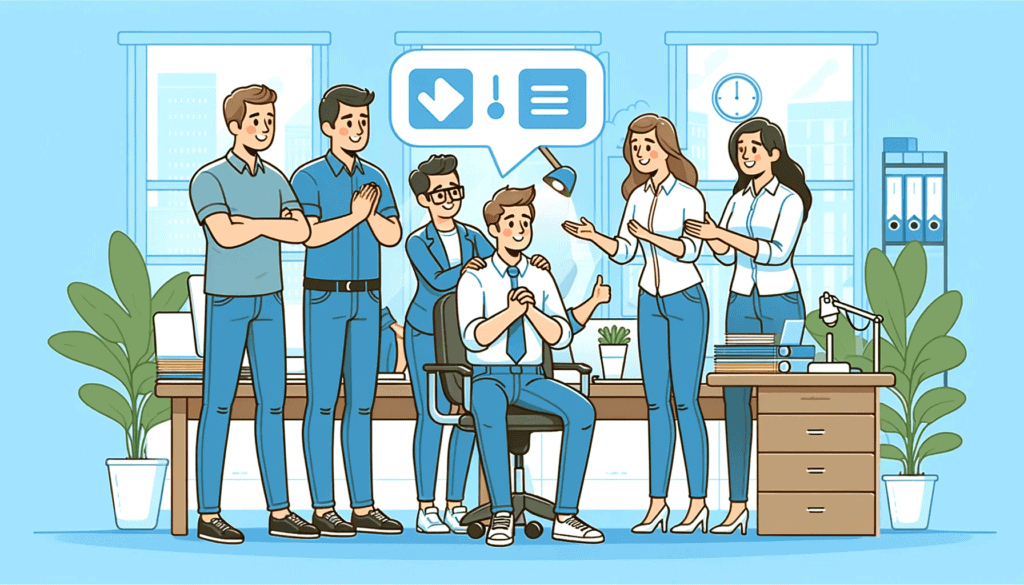Last Updated on January 9, 2024 by Daniel Boyce
Ever felt targeted by a coworker trying to undermine you?
You’re not alone.
In today’s professional world, it’s essential to know how to recognize and handle such challenging situations.

This article provides a roadmap for how to deal with a coworker who is trying to get you fired.
From identifying subtle signs of negative behavior to effective confrontation strategies, we cover it all.
We’ll also delve into the importance of documentation, building support systems, and when to involve HR.
Prepare to arm yourself with practical tips and insights to navigate these workplace challenges with confidence and professionalism.
Recognizing the Situation
Recognizing the situation when you suspect a coworker is trying to get you fired is crucial in any work environment.
It begins with understanding the dynamics between you and your colleagues.
Often, subtle cues in behavior or changes in attitude can be early indicators.
According to this survey from comparably, “A negative personality is the worst quality a coworker could have.“
Are you finding your coworker’s demeanor towards you increasingly hostile or dismissive?
Do they have a pattern of undermining your efforts at work?
It’s important to objectively assess the situation without jumping to conclusions.
Remember, a problematic coworker doesn’t always equate to them trying to get you fired.
Consider the overall team dynamics and how your interactions fit within that context.
Signs Your Coworker is Trying to Get You Get Fired
Navigating the complexities of office dynamics can be tricky, especially when you suspect a colleague might be trying to get you fired.
Identifying these covert efforts is crucial in maintaining a healthy work environment.
Here are some telltale signs to watch out for:
- Misinformation Spread: Your coworker deliberately shares false information about you or your work.
- Misrepresentation of Contributions: They downplay or take credit for your efforts.
- Alienation Efforts: Attempts are made to isolate you from the rest of the team.
- Problematic Communication: You receive emails or messages from them that are undermining or hostile.
- Targeted Behavior: Noticeable patterns of actions aimed specifically at discrediting or sabotaging you.
Recognizing these behaviors enables you to effectively tackle the challenge of a coworker attempting to undermine your position, ensuring you maintain professional integrity and team cohesion.
Direct Communication and Confrontation
When dealing with a coworker who may be trying to get you fired, direct communication and confrontation can be effective.
The key is to approach the situation professionally.
Direct communication in the workplace involves clear and straightforward sharing of thoughts and instructions, ensuring clarity in who is responsible for directives and what those directives are.
This approach minimizes confusion and aligns everyone with their tasks and roles.
Schedule a private meeting with your colleague to discuss your concerns.
Be clear and specific about the incidents that have led you to believe they are trying to undermine you.
It’s important to stay calm and not accuse them directly, but rather express how their actions make you feel.
This approach can sometimes resolve misunderstandings and can lead to improved work relationships.
Remember, it’s about finding a resolution and maintaining a positive work environment.
Strategies to Confront and Stop a Coworker
Dealing with a coworker who may be trying to get you fired can be a delicate situation that requires a careful blend of assertiveness and diplomacy.
Here’s a roadmap to help you navigate these challenges:
- Document Specific Incidents: Keep a detailed record of any inappropriate behavior or actions that seem targeted at getting you fired.
- Understand Their Perspective: Try to identify any underlying reasons for their behavior, as this can offer insights for resolution.
- Engage in Open Dialogue: Communicate your concerns clearly, while also being receptive to their side of the story.
- Offer Constructive Solutions: Propose ways to improve team dynamics and work collaboratively.
- Direct Communication: Have a candid conversation focusing on the impact of their actions on the team and work environment.
- Seek Support and Escalate if Necessary: If direct communication doesn’t lead to improvement, don’t hesitate to involve a supervisor or HR for further intervention.
Successfully handling a problematic coworker often involves a strategic approach.
You need to document problematic behaviors, communicate your concerns clearly, and be prepared to escalate the issue if necessary.
Understanding their perspective can also be key in resolving the issue.
Remember, the ultimate goal is to maintain a positive and productive work environment, ensuring that both you and your coworkers can thrive.
Documentation and Evidence

| Workplace Situation | Type of Documentation or Evidence to Collect |
|---|---|
| 1. Hostile or undermining comments during meetings | Record the date, time, and context of the comments. Note down who was present and the specific words used. If possible, follow up with an email to the coworker seeking clarification, and keep their response. |
| 2. Exclusion from important emails or meetings | Keep records of instances when you were left out, including dates and the nature of the meetings or emails. Maintain a list of projects or decisions you were excluded from. |
| 3. Misrepresentation of your work or contributions | Document specific examples where your work was misrepresented. Save any related work products, emails, or reports that accurately depict your contributions. |
| 4. Spreading rumors or false information about you | Collect statements or written evidence from colleagues who have heard these rumors. Document the date, time, and the content of these rumors. |
| 5. Unjustified negative performance reviews or feedback | Keep a record of all performance reviews and feedback. Compare them with your job responsibilities, accomplishments, and any contradictory positive feedback or emails praising your work. |
| 6. Aggressive or inappropriate emails and messages | Save all correspondence that contains aggressive or inappropriate language. Pay attention to the tone and content, and save any responses you made that showcase your professionalism. |
| 7. Attempts to sabotage your work | Document instances of sabotage, including what happened, when, and the potential impact on your work. Keep any evidence that shows your original work and the changes or actions taken against it. |
| 8. Direct threats or intimidations | Record the specifics of any threats or intimidating behavior, including the date, time, and exact wording. Report these incidents immediately to HR or management. |
In each of these situations, it’s important to maintain a clear and factual record.
This documentation not only supports your case if you need to escalate the issue but also demonstrates your professional and responsible approach to handling workplace conflicts.
Importance of Documenting Instances
For workplace issues, especially discrimination, it’s advisable to formally notify your employer, preferably in writing like an email.
If you’ve already raised concerns verbally, follow up with an email to both your manager and HR, detailing the specific discrimination issues you’re facing.
This ensures there’s a clear, documented trail of your complaint.
Proper documentation also demonstrates to your supervisors and HR that you are taking a proactive and professional approach to resolving the issue, which can be beneficial for your own work record.
Maintaining Professionalism
Dealing with a coworker trying to get you fired demands professionalism and a blend of tact and assertiveness.
It’s crucial to manage emotions and address issues directly yet respectfully.
If unresolved, escalate the matter to management or HR with specific evidence.
Strive to understand the coworker’s perspective and use “I” statements to express how their actions impact you, facilitating a constructive dialogue.
Focus on your work and avoid negative talk about your colleague, as this maintains your integrity. Seeking advice from a mentor or HR can guide you in navigating these challenges.
This approach not only protects your position but also sets a positive example in your work environment.
Building Support Systems
When dealing with the challenging situation of a coworker trying to get you fired, building a strong support system at work is invaluable.
Here are some benefits of having such a network:
- Emotional Support: Colleagues who understand your situation can provide empathy and reassurance.
- Advice and Guidance: Experienced coworkers can offer practical advice on how to handle tricky situations.
- Counteracting Negative Behavior: A supportive team can help dilute the impact of a problematic coworker’s actions.
- Diverse Perspectives: Allies can offer different viewpoints and strategies to effectively address workplace issues.
- Advocacy: In cases where you’re unfairly targeted, having colleagues who vouch for your contributions can be crucial.

By fostering strong relationships with your colleagues, engaging in team activities, and showing appreciation for their efforts, you build a network that not only enhances your work experience but also provides a sense of security and camaraderie.
Workplace allies can be your advocates, offering emotional support, advice, and sometimes even intervening on your behalf.
Cultivating these relationships and openly communicating your challenges in a non-confrontational manner can turn coworkers into allies, ensuring a more positive and collaborative work environment.
This support system becomes a cornerstone in effectively dealing with any challenges posed by difficult coworkers.
Escalation and Seeking Help
When facing a coworker who’s trying to get you fired, it’s crucial to know when to escalate the issue.
Initially, attempt to resolve it directly in a professional manner.
If this fails and their behavior persists, seek help from a supervisor or HR.
Be ready with concrete examples of the coworker’s actions and their impact on your work.
This proactive stance demonstrates your commitment to resolving the issue professionally.
When to Take the Issue to HR or Management
Deciding to escalate a coworker issue to HR or management is a critical step, typically taken when direct resolution methods fail or if the coworker’s behavior severely impacts your work, mental health, or team dynamics.
It’s essential to document all relevant incidents factually and specifically, clearly articulating their impact on your performance and the team.
When approaching HR or management, do so with respect and professionalism, offering potential solutions.

This approach ensures a fair and objective process, upholding company policies and aiming for a resolution that considers the interests of all parties involved in the work environment.
Conclusion
Navigating the challenges of a coworker trying to get you fired demands a strategic blend of awareness, communication, and self-advocacy.
We’ve explored the importance of recognizing early signs of negative behavior, the effectiveness of direct communication, and the critical role of documentation.
Building a network of workplace allies and knowing when to escalate matters to HR are also key components in safeguarding your professional standing.
Remember, maintaining professionalism and investing in personal growth are your best defenses in a complex work environment.
As Aristotle once said, “The more you know, the more you realize you don’t know.”
This journey doesn’t just protect your job; it propels your personal and professional development.
Share your experiences or thoughts in the comments, and if this article resonated with you, consider passing it along to help others facing similar challenges.
Let’s continue to grow and support each other in our professional endeavors

Daniel Boyce, founder of AwareRecruiter.com, brings a diverse background in health, fitness, sales, and recruitment to career development. He’s passionate about helping professionals overcome workplace challenges and succeed in new roles. Daniel’s vision for AwareRecruiter.com is to create a comprehensive resource for career growth and satisfaction.